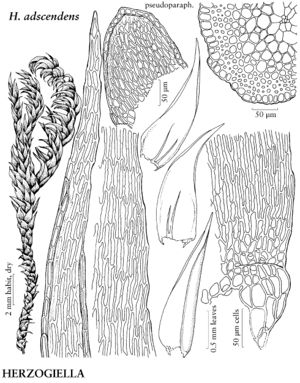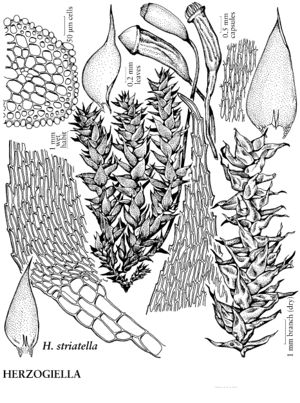Herzogiella
in H. G. A. Engler et al., Nat. Pflanzenfam. ed. 2, 11: 466. 1925.
| Taxon | Illustrator ⠉ | |
|---|---|---|
 | Herzogiella adscendens | Patricia M. Eckel |
 | Herzogiella striatella | Patricia M. Eckel |
Plants medium-sized, in thin to dense mats, light to yellowish or dark green, somewhat glossy to glossy. Stems creeping to ascending or erect, simple or sparingly and irregularly branched; hyalodermis present, sometimes indistinct, central strand usually indistinct or absent; pseudoparaphyllia absent (foliose in H. adscendens). Stem and branch leaves similar, spreading to squarrose, not undulate, ovate or lanceolate, not or weakly plicate; base decurrent or not; margins plane, serrulate to serrate (serrulate to entire in H. adscendens); apex acuminate to long-acuminate; costa double and short or rarely ecostate; alar cells usually clearly differentiated, few quadrate, rectangular, or abruptly inflated, rounded cells present; laminal cells smooth. Specialized asexual reproduction absent. Sexual condition autoicous or dioicous; perichaetial leaves ovatelanceolate, apex gradually acuminate, acumen occasionally filiform. Seta light-brown to red or yellowish. Capsule erect to inclined, oblong or cylindric, straight to arcuate, often contracted below mouth when dry; annulus 2-seriate or 3-seriate, deciduous, cells large; operculum conic to conic-apiculate; peristome double; exostome teeth with external surface cross-striolate proximally, papillose distally; endostome basal membrane high, segments narrow, keeled, cilia 1–3, approximately same length as segments, sometimes absent. Calyptra naked. Spores spheric to ovoid, minutely papillose.
Distribution
North America, Mexico, Central America, South America, Europe, Asia, Africa, terrestrial habitats at low to high elevations predominately in temperate and boreal regions
Discussion
Species 7 (4 in the flora).
Stems of Herzogiella often have large, thin-walled epidermal cells and smaller, thick-walled, cortical cells in few rows. The axillary hairs have two basal cells and two apical cells; the sparse, papillose rhizoids emerge in the leaf axils or just below, or are often restricted to stem bases. The leaves are rigid, symmetric, concave, and sometimes distally secund at the stem and branch apices; there are sometimes 1–4 alar cells along the margins that are differentiated from the thick-walled, linear-fusiform laminal cells. The inflorescences are near the base of stems; the seta is often twisted; the capsule is usually striate when dry, with a wrinkled neck; the exostome teeth are bordered and internally trabeculate; and the endostome is papillose.
Selected References
None.
Lower Taxa
Key
| 1 | Alar cells abruptly inflated, hyaline or orange to red; leaf bases distinctly decurrent | > 2 |
| 1 | Alar cells quadrate to rectangular or rounded to oval and inflated, green; leaf bases not or indistinctly decurrent | > 3 |
| 2 | Leaves often squarrose to squarrose-recurved; margins serrulate to strongly serrate. | Herzogiella striatella |
| 2 | Leaves imbricate to somewhat spreading; margins serrulate to entire. | Herzogiella adscendens |
| 3 | Leaves appearing distichous, not or weakly plicate; capsules 0.8-2 mm. | Herzogiella turfacea |
| 3 | Leaves wide-spreading in several rows, not plicate; capsules 2-3.5 mm. | Herzogiella seligeri |